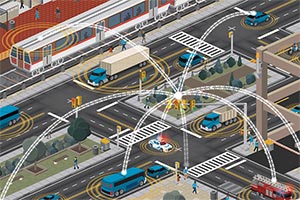USDOT Announces Vehicle-to-Infrastructure Guidance

On their last full days in office, Transportation Secretary Anthony Foxx and Federal Highway Administrator Gregory Nadeau issued guidance to state and local governments for the adoption of vehicle-to-infrastructure programs, or V2I.
The Jan. 19 announcement said, “The guidance complements the department’s efforts to reduce crashes by advancing V2V [vehicle-to-vehicle] communication technology announced in a proposed rule in December.”
“This is an important step in deploying a connected vehicle environment,” the statement said quoting Foxx, now the department’s former secretary.
“In addition to improving safety, vehicle-to-infrastructure technology offers tremendous mobility and environmental benefits,” said Nadeau, now the former administrator.
“We took a big leap forward today by starting a national conversation about these topics, the future of V2I technologies and some of the bigger challenges facing us, such as privacy, security and interoperability,” Nadeau said.
Transportation Department officials see V2I working among modes, listing four agencies taking part in its development in addition to FHWA: Federal Railroad Administration, Federal Transit Administration, Federal Motor Carrier Safety Administration and National Highway Traffic Safety Administration.
It was NHTSA that issued the proposed V2V rule calling for systems to be mandatory in cars and light trucks.
One of the FHWA documents said, “The deployment of V2I technologies is not mandated and is not coupled with” the NHTSA proposal.
“A NHTSA rulemaking will not require state and local departments of transportation to deploy V2I technology,” FHWA said, adding, “It is important for state and local agencies to understand what a decision to deploy V2I technology could mean to their region and how to prepare for the implementation of V2I technology. The V2I deployment guidance provides information for state and local agencies on a broad range of topics as they consider V2I technologies.”

